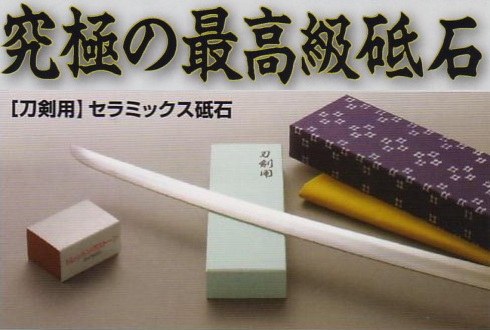Results 1 to 10 of 37
Thread: Japanese Grit vs. American Grit
-
04-10-2009, 12:41 AM #1
 Japanese Grit vs. American Grit
Japanese Grit vs. American Grit
Ok, so a discussion in this thread has kind of brought home some different ides I've been thinking about for a while.
It appears that some of the Japanese synthetic stone makers have some stones that are not available in Japan that ARE available in the US, and vice versa.
For example--there is NO 15,000 Shapton Pro series (刃の黒幕 in Japanese) on the Japanese Shapton website. The closest thing is the 12,000....which, oddly enough, in the color coded series is the same color-cream. According to JimmyHAD, who has both, they are largely indistinguishable except that the 12,000 feels softer. Hmmmm...
Then we come to the Naniwas. The Super series in Japan does NOT have a 12,000--only a 10,000. (here's the same site in English, NOTICE STILL NO 12,000!). This time, however, the coloring is different...
So, here is my question.
If these stones are made in Japan, by Japanese companies, why oh WHY would they make a higher grit, and therefore more expensive and more effective for polishing, stone exclusively for a foreign market? Especially considering that they very likely are MADE AT THE SAME PLANT?
Here are the some possible explanations I have come up with.
1. They feel that since the American market is bigger, it might be more willing to pay a bit more for the slightly higher grit (unlikely--Japanese tool users are VERY willing to pay high prices for quality...).
2. The Shapton stones are, in fact, identical but there is a difference in grit rating in the US making a Japanese 10,000 equal to an American 12,000; 12,000 to 15,000 etc. (JImmyHAD, who is experienced in these things like I never will be, says they are different.) This would also be unlikely, since the other stones have the same numbers...
3. The Shapton stones are identical, and they're just saying it for some weird reason that we Westerners could never understand. Probably something to do with Ninjas.
I go with number 3. Though none of this explains the Naniwa stones....because they still have a 10,000 in the States, right?
Soooo...what have I missed?Last edited by JimR; 04-10-2009 at 12:43 AM.
-
04-10-2009, 01:01 AM #2

What about the Chosera #10000 that comes both in Pink and in Blue?


 笑う門に福来たる。
笑う門に福来たる。
-
04-10-2009, 01:08 AM #3

If I am not mistaken Shapton has a gray series of glass stones that is not yet available in the USA that is intended for Japanese chisels. They use a type of steel with their chisels that is not used on USA or European tools. I forget whether it is white or blue steel but something like that.
The Shapton USA website, while it doesn't carry the 12k, does say in their FAQ that the 12k is meant for stainless. It is worth noting that none of these stones are made for razors. They are all made primarily for woodworkers.
I have spoken the the USA distributor, Harrelson Stanley, more then once and he has told me that the pro and glass lines are different formulas . I imagine the Naniwas are too. These folks are as serious about their hones as we are.
In the photo of the 12 and the 15 I couldn't easily tell them apart so I wrote on the 12 with marker to more easily distinguish it from the 15. Note the factory #s only differ in the letter prefix and they both come in the same color case. Be careful how you treat people on your way up, you may meet them again on your way back down.
Be careful how you treat people on your way up, you may meet them again on your way back down.
-
04-10-2009, 02:22 AM #4
-
04-10-2009, 03:14 AM #5

Well, since the Japanese Shapton only has a 12,000, the cream, which is very VERY similar to the American 15,000 cream (and, incidentelly, many people say the Kitayama is a 10k-12k stone, but the Japanese sites all list it as an 8k...) I was just speculating about the possibility.
I'm not sure what you mean by your post. Why do you say that "American 8k equals Japan 10k"?
-
04-10-2009, 04:58 AM #6

I was thinking about that, too...but then the stones that have the same numbers, i.e. the pro 30,000 is the same in the US and Japan, would they be a different stone in Japan and the USA (same number, different actual grit size)?
It's a mystery...I dropped an email to Naniwa asking why the 12,000 wasn't available in Japan, maybe there' ll be some kind of roundabout explanation. I'll contact Shapton later today...I suppose I should actully do some work at some point.
-
04-10-2009, 05:04 AM #7
-
04-10-2009, 05:16 AM #8

This is great
 We don't know what grit the natural stones are and now we don't know what grit the Shaptons and Naniwas are
We don't know what grit the natural stones are and now we don't know what grit the Shaptons and Naniwas are 
 Be careful how you treat people on your way up, you may meet them again on your way back down.
Be careful how you treat people on your way up, you may meet them again on your way back down.
-
04-10-2009, 05:24 AM #9
-
04-10-2009, 05:27 AM #10


 LinkBack URL
LinkBack URL About LinkBacks
About LinkBacks








 Reply With Quote
Reply With Quote

